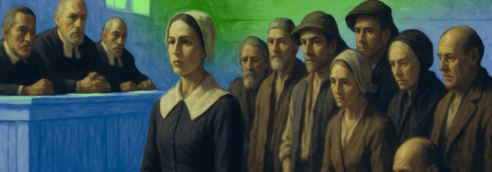|
Character
|
Traits or motivations
|
Quotes or actions that show consent of the governed or pressure to conform
|
Function in the play
|
|
Abigail Williams
|
Manipulative and intimidating
|
Threatening the other girls with their lives if they say anything other than they were dancing in the forest that night shows pressure to conform.
|
This part of act 1 shows how coercive Abigail is and how she uses her influence to silence the other girls and keep the truth hidden.
|
|
Mary Warren
|
Intimidated and frightened
|
Gives Elizabeth a doll that she sewed in court. This act illuminates the pressure to conform because it turns out that Abigail used the doll gifted as a way to “prove” that Elizabeth is a witch.
|
The manipulation that occurs at this point in the story shows how conniving Abigail is and
how much the other girls, such as Mary Warren, have fearfully fallen “under her spell.”
|
| John Proctor |
Realistic and honest |
After Reverend Hale tells Proctor that the girls have confessed to witchcraft, Proctor says the reason the girls confessed is because if they didn’t, they would have been hanged. This dissent through discourse shows a belief in his own human dignity and desire to act for the common good by debunking the witchcraft myth. |
Proctor’s reasonable responses and willingness to respond with truth and dissent shows he believes an individual has a right to speak to a governmental body (i.e., Hale and other accusers). |
| Elizabeth Proctor |
Honest |
When she asks John to go to the court and tell them what Abigail told him it shows a belief in the consent of the governed. |
This incident shows that Elizabeth, like her husband, believes that every individual should have an equal part to play in the judicial process. Everyone’s voice should matter—not just 1 voice or a few voices.
|
| Reverend Hale |
Suspicious |
Asks the Proctors to recite the Ten Commandments to prove that they have a Christian household. This request is pressure for the Proctors to “prove their innocence” by conforming to the community’s values, because they do not attend church regularly.
|
This incident shows how small the pressure to conform can be. It can be as simple as being asked to recite something from the Bible because the person does not go to church. |
| Francis Nurse |
Honest and rational |
Brings evidence to the court to show that the girls are not involved in witchcraft. This action shows Nurse’s belief in the consent of the governed because, like Corey, he believes individuals such as himself should have a say in governmental/judicial decisions.
|
This incident shows how deceived everyone is by the governmental powers of Salem because even though Nurse believes he has a say in court proceedings, he actually doesn’t.
|
| Ezekiel Cheever |
Desire to please |
He tells Governor Deputy Danforth that Proctor ripped up the warrant for Elizabeth’s arrest, which shows that he puts pressure on Proctor to conform. This shows Cheever’s desire to conform.
|
By telling this tidbit of information to Danforth, Cheever is contributing to the pressure to conform by giving Danforth some information but omitting other pieces of information (like the doll was Mary’s).
|
| Judge Hathorne |
Authoritative |
By removing Giles from the courtroom, Hathorne silences him and adds to the chilling effect that increases pressure on the situation. |
This move contributes to the overall chilling effect that is occurring as the pressure to conform grows stronger in the courtroom.
|
| Giles Corey |
Brash and desperate |
Crying out in court that he has proof that Putnam is trying to gain as much land as possible shows that Giles believes in the principle that his evidence should matter and individuals should participate in governmental (i.e., judicial) decisions.
|
His unwavering belief in due process and earnest desire to provide proof is sad because the audience can see that every attempt to tell the truth, be transparent, and speak up is being thwarted. |

